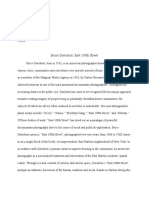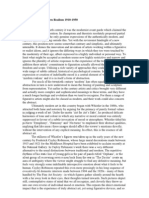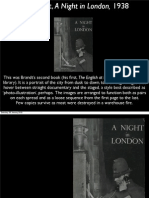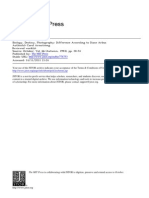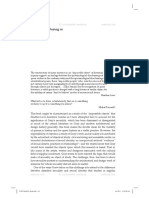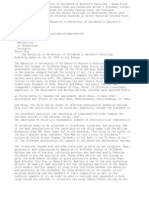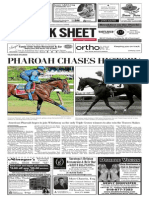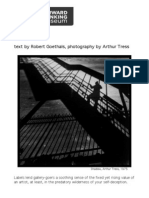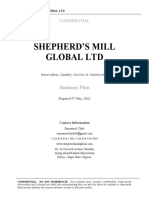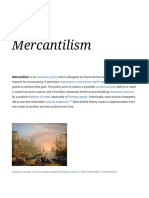INSCRIPTIONSIN ARCADIA
illustrious and unknown: this was what Degas aspired to be, and whatCy Twombly has become.1His imposing reputation has an aura of myth andambiguity, for reasons that have partly to do with the elusiveness of the artisthimself (residing abroad and protective of his privacy), but more to do with thesingularity of his art. Twombly first came to prominence in the later 1950s, whenhis graffiti-like pencilwork appeared to subvert Abstract Expressionism. Yet hethen sustained painterly abstraction through a time in the 1960s when theimagery of mass culture and the certainties of geometry seemed destined to kill itoff. While linked by generational ties and friendship to Robert Rauschenbergand Jasper Johns, he has suffered from the fact that unlike theirs, his work—withno bold graphic or photographic imagery—tells little in reproduction, and provides no convenient entrance into Pop art. The elements of ironic realism intheir art have been considered progressive and in tune with postmodern sensibilities, but Twombly's unique combination of bare astringency and sensual indulgence has proved harder to confine within such tidy generalizations. He hasfurther distanced himself from his contemporaries by embracing the classical pastand reaching for epic narrative in an era when such models appeared whollyderelict. In addition, his work has often sought its own poetics by invoking theheritage of literature, during a long period in which "literary" was a term of condemnation. These commitments, and their author, have never found a readyniche in accounts of the progress of art since 1950. The countless paperbacks andcatalogues that have canonized the line of artists from Pollock to Warhol as themainstream of American art's postwar ascendancy have typically neglectedTwombly rather than contend with the ways his inclusion might disrupt thatstory's flow. A fellow artist already saw the problem in 1955: "[Twombly's]originality," he said, "is being himself. He seems to be born out of our time,rather than into it."2That assessment cannot satisfy: no person has such autonomy, and clearlyTwombly's art is specifically contemporary. Efforts to link him to the art of histime have left us, though, with an oddly piecemeal fabric of interpretations— one which only now, in the mid-1990s, appears to be assuming enough breadthand density to wrap the complex achievements of the work itself. Over almostthree decades, Twombly has been repeatedly "rediscovered" by American critics,in various ways. The white-on-grey paintings he made in the late 1960s werewelcomed as having an anti-sensual, cerebral spareness that related them toMinimalism and Conceptual art; and the fascination with linguistic models of criticism focused special attention on the play of marking, writing, and schematicfiguration in his work. Then, more important, American awareness of Europeancontemporary art expanded: in the 1970s a sharpened focus on the art of JosephBeuys—concerned with grand myth and history, but also esoterically personaland tied to a bodily animism—began a reorientation that favored Twombly inother ways; and the advent of a new painterly expressionism in the 1980s, inartists as diverse as Anselm Kiefer and Francesco Clemente, further catalyzed afresh assessment of his importance.More recently a fraught concern with sexuality has appeared among contemporary artists whose anti-formal expressivity and candor about the body has
9

opened still another avenue into Twombly's complex achievement. As did theearlier frames of reference (Abstract Expressionism, Neo-Dada, Minimal andConceptual art, Neo-Expressionism, and so on), this one can help us see validaspects of the work. Taken in sequence, however, each of these terms has tendedto exclude or ignore the others, and none accounts for the presence withinTwombly's art of all these, and more, contradictory climates of feeling. Offhandimpulsiveness and obsessive systems; the defiling urge toward what is base andthe complementary love for lyric poetry and the grand legacy of high Westernculture; written words, counting systems, geometry, ideographic signs, andabstract fingerwork with paint—all ask to be understood in concert.In that complexity, this art has proved influential among artists, discomfiting to many critics, and truculently difficult not just for a broad public, but for sophisticated initiates of postwar art as well. It will almost certainly continue todefy ready acceptance by a wide audience, as its particular impact depends sostrongly on the kind of direct response to physical presence that is resistant toverbalization and uncongenial to analysis. In the extensive literature on Twombly,many sensitive writers and acute theoreticians have already grappled with thatdifficulty, in efforts to capture poetically the seductive force of his work, andto analyze its singular aesthetic structure. With respect for and indebtedness tomany of their texts, this retrospective essay approaches its subject in a differentand perhaps more prosaic fashion, by attempting to examine the art within thecontext of a fuller account of the basic circumstances of time, place, and biogra phy in which it has been made.It is, after all, not just the internal complexity of any given work that is sochallenging; the several shifts and turns this long career has seen, and the varietiesof feeling that shape its different periods, also confound generalizations. Yet— amazingly, given Twombly's stature—there still exists no standard, documentedhistory of exactly what has happened in the evolution of his art, when, and inwhat order. The dates and the durations of his formative experiences have beenonly vaguely sketched out in writing on him, and the shifting locales in whichhe has worked (clearly understood by his intimates as central to the variety of his production) are known to outsiders only as a string of often unfamiliar names— Sperlonga, Bassano, Bolsena, Gaeta, and so on (see map, fig. 47, in the notes). If weare ever to come to firmer grips with the art in its broader implications and historical role, we would do well to start by better understanding these basic matters,and trying to integrate them into a reliable chronicle of Twombly's experience.This will not of course "explain" anything: a creator's work is never reducible tohis or her life, and lives are themselves constructs that need interpretation. Yetfew artists' work seems so closely—one wants to say so nakedly—tied to thevicissitudes of an individual temperament unfolding in time. Historians musteventually reckon with the specifics of that connection, not because such factswill provide answers, but because they will help us frame more telling questions.The crucial first step has already been taken by Heiner Bastian in hissuperb catalogue raisonne of Twombly's paintings, which is mapping the extentof the oeuvre, allowing us to see countless little-known canvases, and establishing an order.3With that reference in hand, we can now trace the developmentof the work, and, with the artist's generous cooperation and the help of newdocumentation, begin to chronicle more fully his life and art in tandem. Thethumbnail biography that has been ritually repeated throughout the literaturecites, for example, three formative episodes: his childhood in Virginia; his education in Boston and New York and at Black Mountain; and his move to Italy in1957. We can start simply by reexamining these givens, and reassessing what theyhave meant for Twombly as an artist—with the intent that through such effortshe should become a little less unknown, and thereby the more illustrious.
EARLY LIFE AND EDUCATION, 1928- 52
Edwin Parker Twombly, Jr., was born on April 25, 1928, at Stonewall JacksonHospital in Lexington, Virginia. Second child and only son, he inherited thenickname his father had earned—recalling the legendary pitcher Cy Young— as a professional baseball player.4Both parents were Northeasterners by birth, but the South was vital to the family's experience and Twombly has remainedunmistakably Southern in important aspects of his presence and character. '1Therhythm of his childhood, inflected by regular sojourns with his extended familyin Massachusetts and Maine, involved what he sees as a happy alternation of two basic American cultures. The family's roots in New England supplied cooler,analytic elements of Yankee temperament, but it is the South, he feels, that ismore closely allied with the Mediterranean world he embraced as an adult.Virginia and Italy, Twombly maintains only half jokingly, are both Mediterraneancultures.That connection is long-standing: the antebellum South had a special veinof neoclassicism, from Thomas Jefferson's Palladian buildings at Charlottesvilleand Monticello through the pedimented porticoes of plantation architecture, tothe Latin names frequently imposed on slaves. More generally, the traditionalelements that thickened the "atmosphere" of Southern life—a honeyed easewith spoken language and a rich literary tradition, a certain sensual languor, and
the lingering romance of fallen grandeur—could all be taken to have predisposedTwombly toward the Roman life he later chose. There are also other, less evident strains of Southern culture that Twombly understands explicitly, including adark current of fantasy and irrationality, just as there are more specific aspects of his birthplace that helped form him.Lexington, set in the Blue Ridge Mountains west of the Shenandoah,is dominated by two institutions: Washington and Lee University, whereTwombly's father worked as coach and later athletic director/' and the VirginiaMilitary Institute. The community's bookstores and faculties opened horizonsand encouraged ambitions in ways that belied the usual limitations of a smalltown. The military college also added a special dimension. Within the OldSouth, the uniformed cavalier had always constituted a special ideal of aristocracy, fostering the cult of honor and the formalities of chivalry; nowhere wouldthis have been more evident than in the place where Robert E. Lee andStonewall Jackson taught and are buried.7In Twombly's youth, when local sonsand daughters of Confederate soldiers still retained memories of Manassas theyhad learned at the knee, this association among historical myth, cultural grace,and arms would have been especially pervasive. It might seem to have littledirect bearing on art, but on an imagination later fired by Troy and Thermopylae,it left its imprint. (In 1975, Twombly made a collage whose title, Mars and theArtist [pi. 83], specifically associated creativity with the god of war.) Moreover,the military households in Lexington—more spartan than other homes, butoften informed by wider travel and experience of the world—displayed their porcelain and other fine objects in an austere and focused isolation that Twomblyrecalls as one of his earliest experiences of aesthetic sophistication.sAs for true artistic instruction, though, Lexington was barren. Twomblywas artistically gifted and precociously facile at working with his hands, and his parents and teachers encouraged him.9Yet his training might have dependedonly on the Sears, Roebuck art kits he ordered by mail, if Pierre Daura (aSpanish artist connected to Virginia by marriage and driven from Europe by theoutbreak of war) had not settled nearby and started giving private lessons justwhen Twombly, at the age of twelve, began to devote significant energy to painting. As a veteran of the avant-garde and an adept of the Cercle et Carregroup in France, Daura opened an avenue out of the provincial South towardthe tradition that extended from Paul Cezanne into modern European art.10Twombly embraced that tradition swiftly. The first painting he remembersmaking was a copy of Marie-Therese Walter slumbering on the cover of JeanCassou's 1937 book on Picasso; and on his sixteenth birthday, his mother gave
1. Cy Twombly with untitled assemblage (no longer extant),Groveland, Massachusetts. 1946
him Sheldon Cheney's A Primer of Modern Art, which he says he "devoured."Cheney's book was less a history than an evangelical tract: it trumpeted thevisionary courage of the modern movement, sneered at bourgeois tastes, and— with a grudging nod to Cubism, but no regard for geometric abstraction— preached that the tradition of expressionism manifest in artists such as Oskar Kokoschka was the true legacy of Cezanne and the royal road of contemporarycreativity.11Twombly's first formal art school training, in Boston after high school,reinforced this emphasis.12Though the School of the Museum of Fine Artsemphasized practical matters of technique and materials with an eye to trainingteachers, it had a bias toward German aesthetics and was a seedbed of the expressionist painting that flourished in Boston in the late 1940s.13The local Institute of Contemporary Art shared that orientation. In contrast to the perceived prejudices of The Museum of Modern Art in New York, it favored Northern Europeover Paris as the central terrain of the modern tradition, and figurative over non-objective painting.14Twombly visited the Institute often; to the extent that itvalued regionalism and mistrusted abstract art, its programs would have helpeddelay his awareness of the avant-garde in New York and focus him instead on aEuropean expressionist heritage. In this vein, aside from such figures at theschool as the German Karl Zerbe and locals such as Hyman Bloom, more exalted
1
6. Cy Twombly. Didim. 1951. House paint on masonite, 18 X 24V4"(46 X 61.5 cm). Collection the artist5. Cy Twombly. Landscape. 1951. House paint, oil, and paper collage on wood,11 X 21" (27.9 X 53.3 cm). Collection Paine Webber Group Inc.
Some of the earlier works bear such titles as The Slaughter and AttackingImage, and as late as April 1951 the artist could write that the emphasis of his artwas on "movement and power."32In contrast, the motifs of the late summer and beyond seem increasingly static in their monumentality, and more evidentlymarked by a form of primitivism that was becoming central to Twombly's art.Such interests may have had early roots—Cheney's book already invited anattention to archaic styles, and Daura's wife, Louise Blair, was known for her interest in prehistoric cave art33—but it was not until after he arrived in NewYork that he acknowledged the fascination. "I've been very interested in the primitive art of the American Indian—of Mexico and Africa," he wrote in late November 1950. "So much art looks affected and tired after seeing the expressive simple directness of their work."34While that sentence could easily have been penned by hundreds of artists,the sentiment in fact informed a specific and personal, threefold attraction: to thefresh simplicity of "primitive" art's forms; to the evocative richness of its agedsurfaces; and to the aura of animistic superstition or obsession that surroundedcertain of its objects. In a statement on his work written in early 1952, Twomblyaffirmed: "For myself the past is the source (for all art is vitally contemporary).I'm drawn to the primitive, the ritual and fetish elements, to the symmetrical plastic order (peculiarly basic to both primitive and classic concepts, so relatingthe two)."35The affinity for symmetry is clear in works like MIN-OE (pi. 3), withits heraldic confrontation between near-identical "personages," and in the seriesof openwork web structures that were, despite their apparent monumentality(fig. 6), based on the small, ancient Iranian metalwork pieces (bits, bridle ornaments, and so on) generically known as Luristan bronzes.36These latter canvasesalso reflect Twombly's companion interest in the corroded surfaces of archeolog-ical artifacts: the rusted crusts of the excavated iron drew him to this ancientmetal. Charles Olson saw that a feel for such aged and soiled textures underlaythe particular poetics of Twombly's painting; after a visit to the studio at Black Mountain in January 1952, Olson wrote: "... the dug up stone figures, thethrown down glyphs, the old sorrels in sheep dirt in caves, the flaking iron: theseare his paintings."37Four years later, after the experience of Europe and NorthAfrica, Twombly would still write (now with broader experience and deeper self-understanding) that "Generally speaking my art has evolved out of the inter est in symbols abstracted, but never the less humanistic; formal as most arts are intheir archaic and classic stages, and a deeply aesthetic sense of eroded or ancientsurfaces of time."38The missing ingredient in this description, however, is the irrational, and
14









